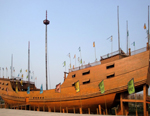Massive Fleet with No Return
Zheng searched for gifts and novelty
China's great Ming Dynasty revolutionized its people and state by working toward stabilization of resources and sustainable farming. During this period, eunuchs, though outcast or positioned as slaves in some circles, were trusted with more power in others. Their castration often resulted in poor social treatment by some, but it also lead to higher levels of trust from emperors, as privy to listen to, and relay messages of political significance on their behalf. From this, favored eunuchs found themselves in more powerful commands with interest to the emperor. In the early fifteenth century, the Yongle emperor entrusted a eunuch, Zheng He, to spearhead one of the largest exploration missions in China's history.
With help from the Yongle empire, massive armadas were constructed with wooden ships so large they would dwarf all others and ultimately face the limitations of floating wood vessels. Zheng commanded what he deemed, Xiafan Guanjun, a fleet capable of literally transporting a city of soldiers, workers, and horses. The size of the armada reached nearly thirty-thousand sailors by the height of exploration missions, something difficult to achieve even in modern times. Around sixty two, nine-mast Boachaun treasure ships composed the fleet's core, surrounded by over a hundred and eighty support ships. The support ships were composted of eight-mast Machuan horse ships, seven-mast Liangchaun grain ships, six-mast Zuochaun troop ships, five-mast Zhanchuan warships, small rowing patrol and water tanker boats.

Xiafan Guanjun followed ancient trading routes on diplomatic missions, procuring sumali qin cobalt used in the production of imperial blue and white porcelain. They sailed on seven prominent voyages from Nanjing off the eastern coast of China, to Sumatra, around the Bay of Bengal, the west India coast, following Arabia into the Red Sea, then along north eastern African coast. Zheng's armada also searched for gifts and novelty for the empire while promoting Ming's power with a daunting array of ships. The fleet was absolutely massive, and in many respects, intimidating as intended. Historical documents give us an idea of just how large Zheng's ships were, and for years archaeologists considered the numbers to be slightly exaggerated. That is, until the discovery of a thirty-six foot rudder in 1957, then two more similar lengths in 2004, at ancient shipyards in Nanjing.
A few calculations confirm, that a ship utilizing a rudder this long is estimated to be over four-hundred and twenty feet long. Rudder size at first coincides with four deck Boachauns by proportion. The ship yard itself, however, reveals possible evidence of even larger, seven deck Boachauns were constructed during the same period. An often debated mystery remains to this day, whether or not Zheng He's ships were actually as large as recorded documents indicate. Wreck sites which would help provide this necessary evidence have not been discovered. What we do know is after the seventh voyage, and despite demonstrated navel success to Chinese court, Xiafan Guanjun was abandoned as the empire sought to align resources elsewhere. Multiple theories have surfaced regarding the fleet's whereabouts and there are no known incidents leading to ship sinking or casualty on a scale as large as the fleet. Partial evidence suggests the armada was left abandoned in harbor after its discontinuation. Furthermore, it may be possible by some accounts that Xiafan Guanjun had been intentionally burned. A considerable amount of resource and wealth of the empire made it possible to float the fleet, but perhaps obtaining cobalt and other reagents we're not enough to offset costs.
